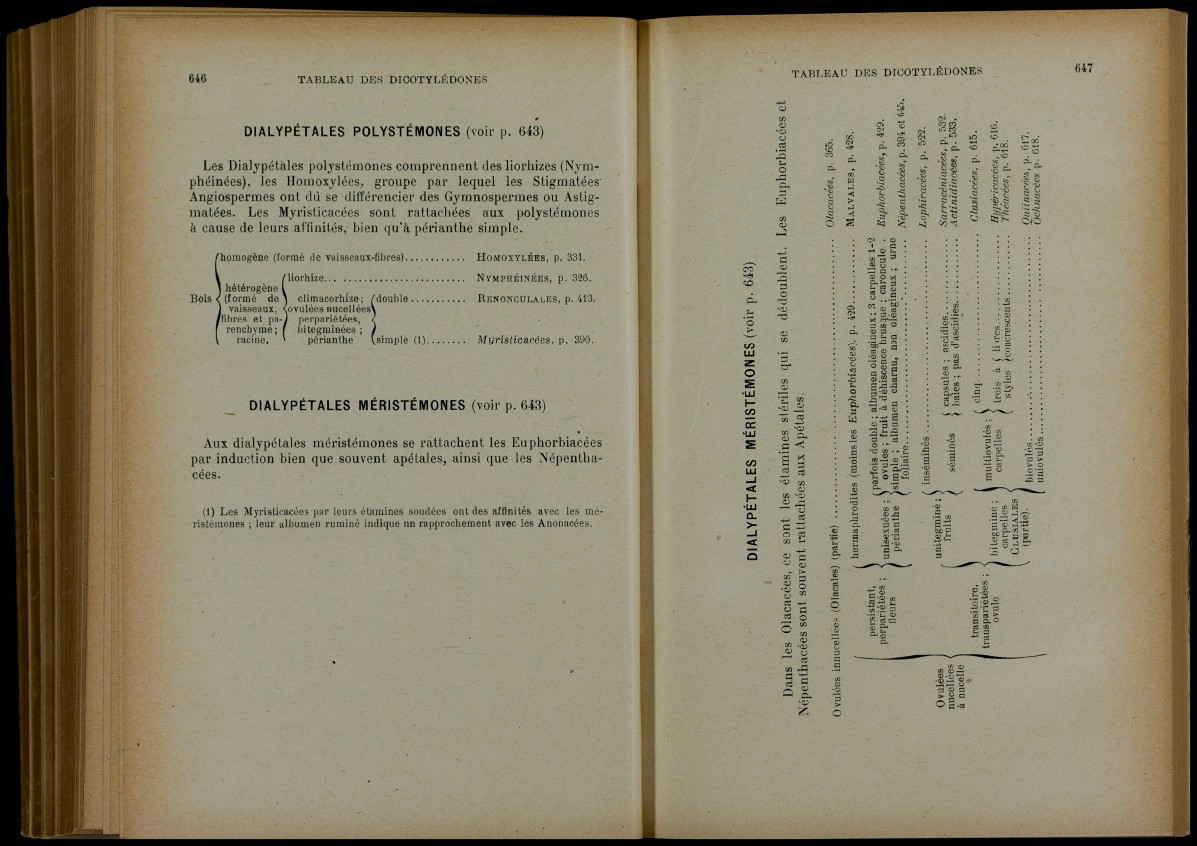
k
6 4 6 TA B L E A U DES DICOTYLÉDONES
DIALYPÉTALES POLYSTÉMONES (voir p. 643)
Les Dialypétales polystémones compr ennent des l iorhizes (Nymp
h é i n é e s ) , les Homoxylées, groupe par lequel les Sligmatées-
A n g i o s p e i ' m e s ont dû se différencier des Gymnospermes ou Astigm
a t é e s . Les Myristicacées sont rattachées aux polystémones
à cause de leurs affinités,- bien qu' à pér ianthe simple.
homogène (formé de vaisseaux-fibres) Homo x y l é e s , p. 331.
Îliorhize Nymphéinées , p. 326.
climacorhize; Mouble Re n o n c u l a l e s , p. 41-3.
ovulées niicellées*
per parié tées,
l)itegminées ;
périanthe ^simple (1) Myristiceicéesj p. 390.
T A B L E A U DES DICOTYLÉDONES 647
DIALYPÉTALES MÉRISTÉMONES (voir p. 643)
•
Aux dialypétales méristémones se rat tachent les Euphorbiacées
p a r induction bien que souvent apétales, ainsi que les Népenthac
é e s .
(1) Les Myristicacées par leurs étamines soudées ont des affinités avec les méristémones
; leur albumen ruminé indique nn rapprochement avec les Anonacées.
fO
CD
Q-.
^O
C/5
UJ
I -
oe
ce
^UJ
C/D
LU
<
h-
^UJ
>a .
<
o
-aO:).
a cô
• i—i
Xi
u
O
Ph
c«
o;
h-3
O)
O
CD
Xfl
Oin)
-53 ^
0 ^
1^ sa
^CU C/3
<D
c« ^o;
Ci oOC f)l ^a 'S S
s §
Scdi os
S -
^ o ^ Oj
II ^O)
00
ro ^
CO çu
m >J
> a<
ce
eos G
«5
O
0c3/: -O)
• >
O
Ci
c•is
es
-C&i
bq
'G
«D
O
CO
Qh
.s
o
•vo
Ci
t
05
Cl.
cqe:) «CD
I
a I
<eput -o«
o« o • » CC
X
O
p.
â
oCO —i cdc
a
(1)
O ^U i
Dce- .
a t(-D*
cC«i o « C3 o
fl
au cd
CO <x>
o s
o g Î3,
o ai
O g •
• 3 = - i l
s ® a -
eu c«
CO <D
- S â
i3 fl
'2f2l Oh
ils
o.
CO CO
. CO ^ lO C•L . 0.-
ci
Co" H 0'ii i
CGN^
s.s
•rg«»,
0CL .
CO
•£ r3H a -CtvO C3
<CDO
izî O
CccO -O • - toce
CO -Cl,
SCO C Oû ;
ce c«
CO -O
a
a
CO
'Qf?l
CO
bC) 53
c
=3
Oes
o— ^ çD
II t. O
tt} c^
3 (aD oC3/ o
'7i
•C I-H o
•§il « •S Ci
S o
0^0
CO CO
SDi. S1— 1 C.O 'OCO
0 0 dUn, =3 > 1—< « > 0
S .-G2' 30
• CDC O «
—i.dH 0) ^J
oac OH CO f0e ^
fe ce • -H0 0
CO ceS > ace CoO-O
CO CO<D d—) 4 Ci -03
3 -J
> H G